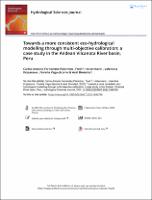Towards a more consistent eco-hydrological modelling through multi-objective calibration: a case study in the Andean Vilcanota River basin, Peru
Metadata
Show full item recordAuthor(s)
Date
2020Subject
SWAT - Hidrología - Hydrological Modelling - Modelos - Topografía - Calibración - Cuencas - EcologíaCollections
- Artículo científico [171]
Related Resource(s)
https://www.tandfonline.com/doi/full/10.1080/02626667.2020.1846740Abstract
Most hydrological studies rely on a model calibrated using discharge alone. However, judging the model reliability based on such calibration is problematic, as it does not guarantee the correct representation of internal hydrological processes. This study aims (a) to develop a comprehensive multi-objective calibration framework using remote sensing vegetation data and hydrological signatures (flow duration curve – FDC, and baseflow index) in addition to discharge, and (b) to apply this framework for calibration of the Soil and Water Assessment Tool (SWAT) in a typical Andean catchment. Overall, our calibration approach outperformed traditional discharge-based and FDC signature-based calibration strategies in terms of vegetation, streamflow, and flow partitioning simulation. New hydrological insights for the region are the following: baseflow is the main component of the streamflow sustaining the long dry-season flow, and pasture areas offer higher water yield and baseflow than other land-cover types. The proposed approach could be used in other data-scarce regions with complex topography.
The following license files are associated with this item:








